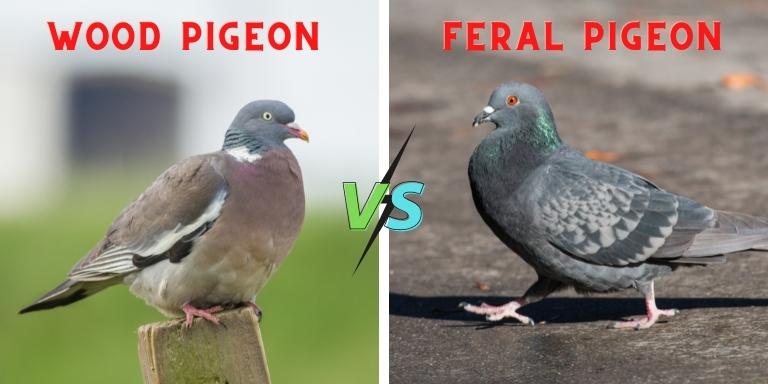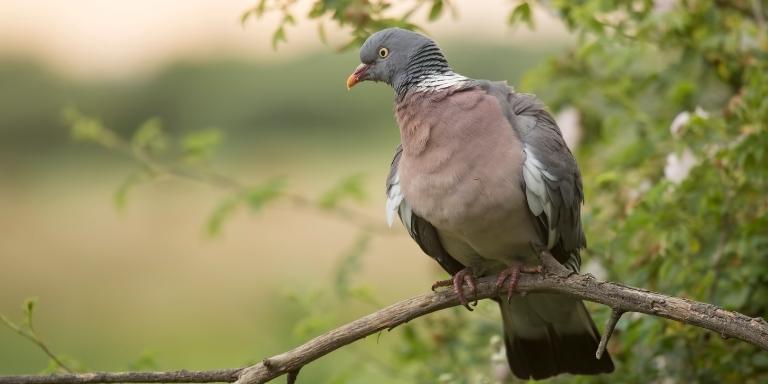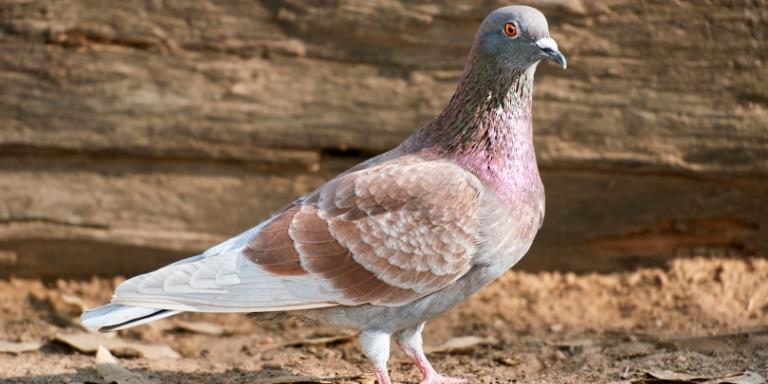We often see a flock of pigeons roaming around the city. All pigeons look the same at first but can actually we tell which pigeon is of what type? It isn’t very clear. But, we can always look for the traits, behaviors, body structures, characteristics to compare each type.

Wood Pigeons

Wood pigeons are the most common type of pigeons and are the largest in number. We often see them around gardens and trees. You may hear their husky ‘cooing’ from far away. They make flimsy nests in quiet places. They are often found in rural areas, so they are more prone to foxes.
- Call – ‘Oooh oooh ooh ooooh ooh.’
- Identify quickly by spotting white patches on the neck, wings, and pink breast.
- When to see – January – December
Feral pigeons

Often referred to as urban rats, they are mainly descendants of the domestic kind that returned to the wild. Feral pigeons are found in almost every city where they are seen as a ‘nuisance.’ Even ‘Dummy Egg Nesting’ projects are undertaken to control their population. Feral pigeons have been most helpful to humans as they were widely used as messenger birds tracking back from ancient times to modern war history.
- Call- ‘Crrooo’.
- How to identify – It comes in all shades, primarily seen in grey-blue, resembling their ancestor Rock Doves.
- When to see – January – December
Wood Vs. Feral Pigeon – Comparison Chart
| Comparison by | Wood Pigeon | Feral Pigeon |
|---|---|---|
| Scientific name | Columba palumbus | Columba livia domestica |
| Length | 40 – 45 cm | 30 – 35 cm |
| Weight | 300 – 620 g | 240 – 380 g |
| Wingspan | 68 – 80 cm | 60 – 68 cm |
| Diet | Seeds, grains, leaves, fruit, peas, and root crops | Seeds, grains, cereal crops, plant seeds, and peas |
| Average lifespan | 3 – 4 years | 3 – 4 years |
| Conservation status | Recently has been assessed for IUCN Red List – Increasing, Least Concern Species in 2018 | Assessed for IUCN Red List – Decreasing, Least Concern Species in 2016 |
| Population | Up to 73 Millions | Up to 120 Millions |
| Habitat | Northern and Eastern parts of Europe and western Asia. | Worldwide |
How can you distinguish a wood pigeon from a feral pigeon?
Both the pigeons have almost the same lifespan, diet habits, and behaviors. There are the features that distinguish them:
Size: Feral pigeons are smaller in size than woodpigeons.
Physical Appearance: Wood Pigeons have a pinker breast, darker rump, and black edges on the wings, while feral pigeons come in all shades, ranging from pale grey to cinnamon brown with glossy greenish, yellowish, and purple iridescence. Female Ferals show less iridescence.
Habitat: if you spot a pigeon in popular city places, it’s most likely a Feral pigeon. On the contrary, wood pigeons are more of a common sight in the countryside.
Interesting fact- Despite the differences in breeding and ancestry, both wood and feral can coexist in harmony. Watch them feeding seeds together in complete bliss!
Feral Vs. Wood – Which one should you pet?
Wood pigeons are a wild species, and woodies generally do not do well in captivity. They are better in the woods on their own. They are a bit on the pickier side regarding food and habitat. Although, hand-reared wood pigeons are an exception.
Feral pigeons are an amazing choice if you want to pet them. They are friendly and easier to tame. Also, petting feral pigeons is an option from an ethical sense as more and more city pigeons need shelter and human support.
Do Wood and Feral pigeons recognize humans?
Yes, both Feral and Wood pigeons are great at recognizing faces. If you’re in Trafalgar Square for a holiday and give a handful of sunflower seeds to pigeons, they will remember you even after years. Changed clothes don’t fool them; on the contrary, if you shoo away them, pigeons remember that too!
Are pigeons vermin?
Yes. As found mostly in cities, Feral pigeons are indeed vermin. They are also referred to as ‘Flying rats.’ Ergo, it’s necessary to control and maintain them. Many crowded towns are infested with pigeons, and they cause nuisance among pedestrians. Pigeon droppings impose a significant public health risk. They carry fleas and parasites like other vermin. Also, they carry all the diseases you would expect from vermin in their feces.
Appreciate the Differences
Every species is beautiful in its way. Know your pigeons, their origin, and their characteristics. We should appreciate their differences and treat them according to their needs.
You might also be interested in: